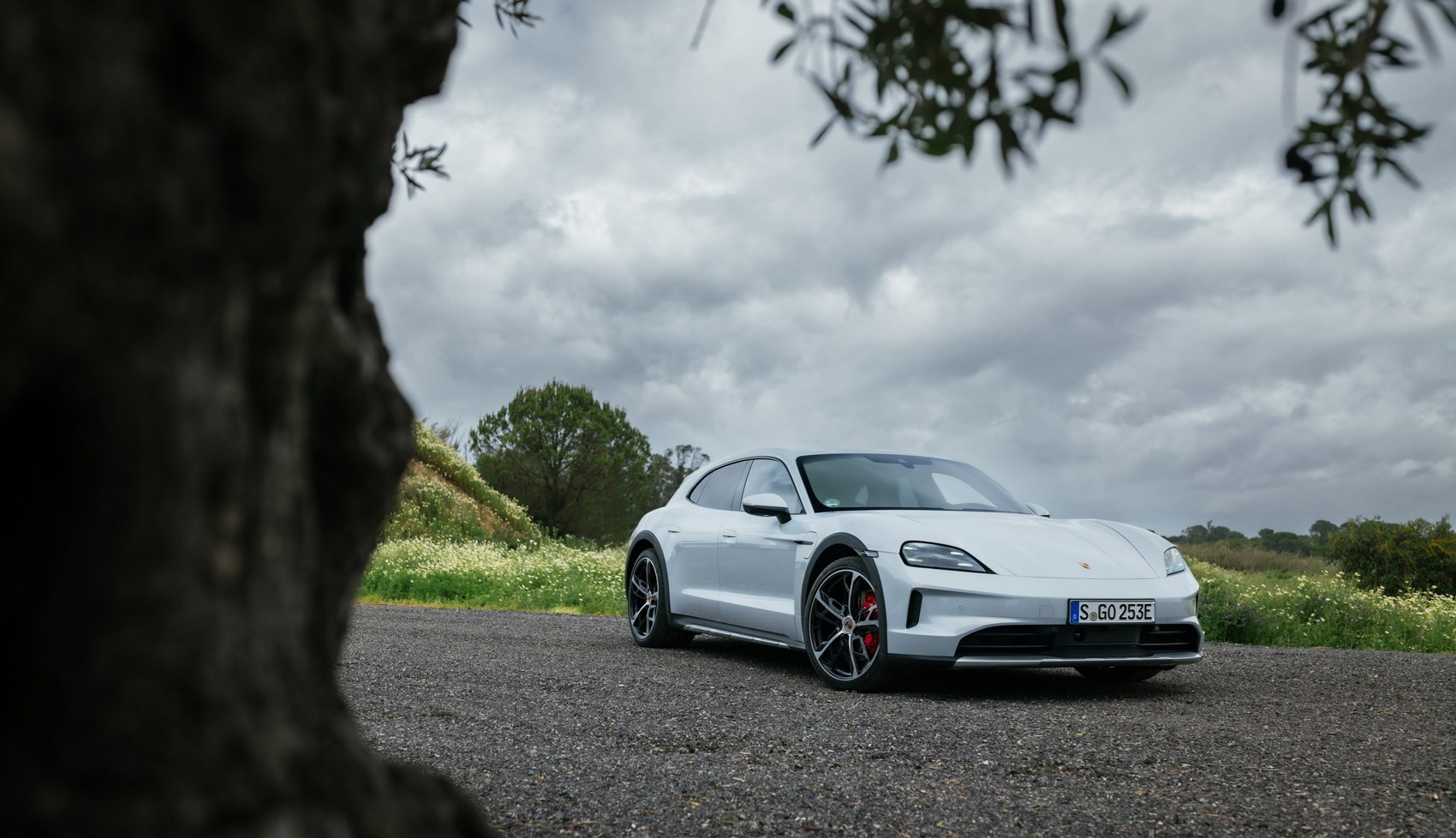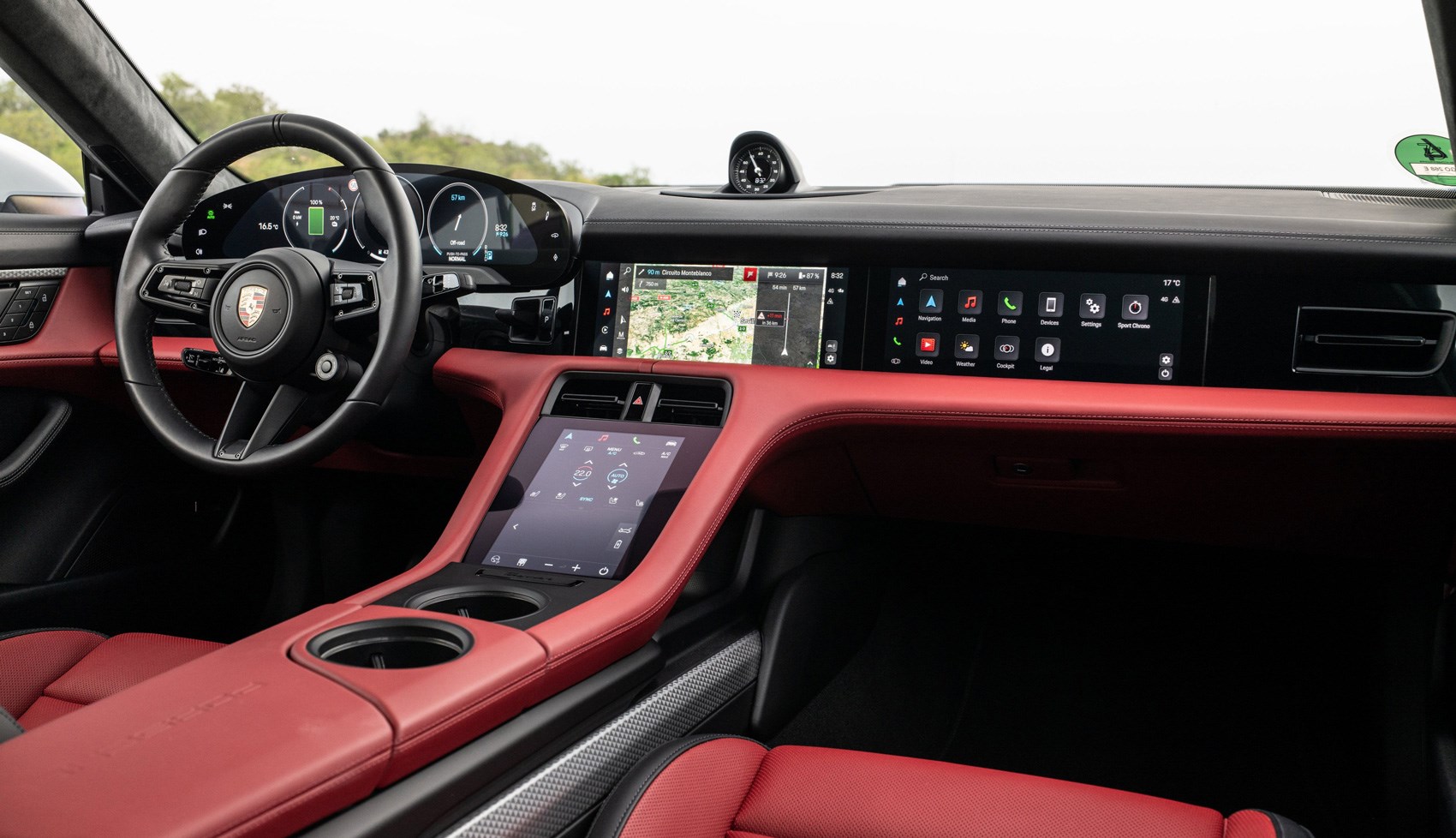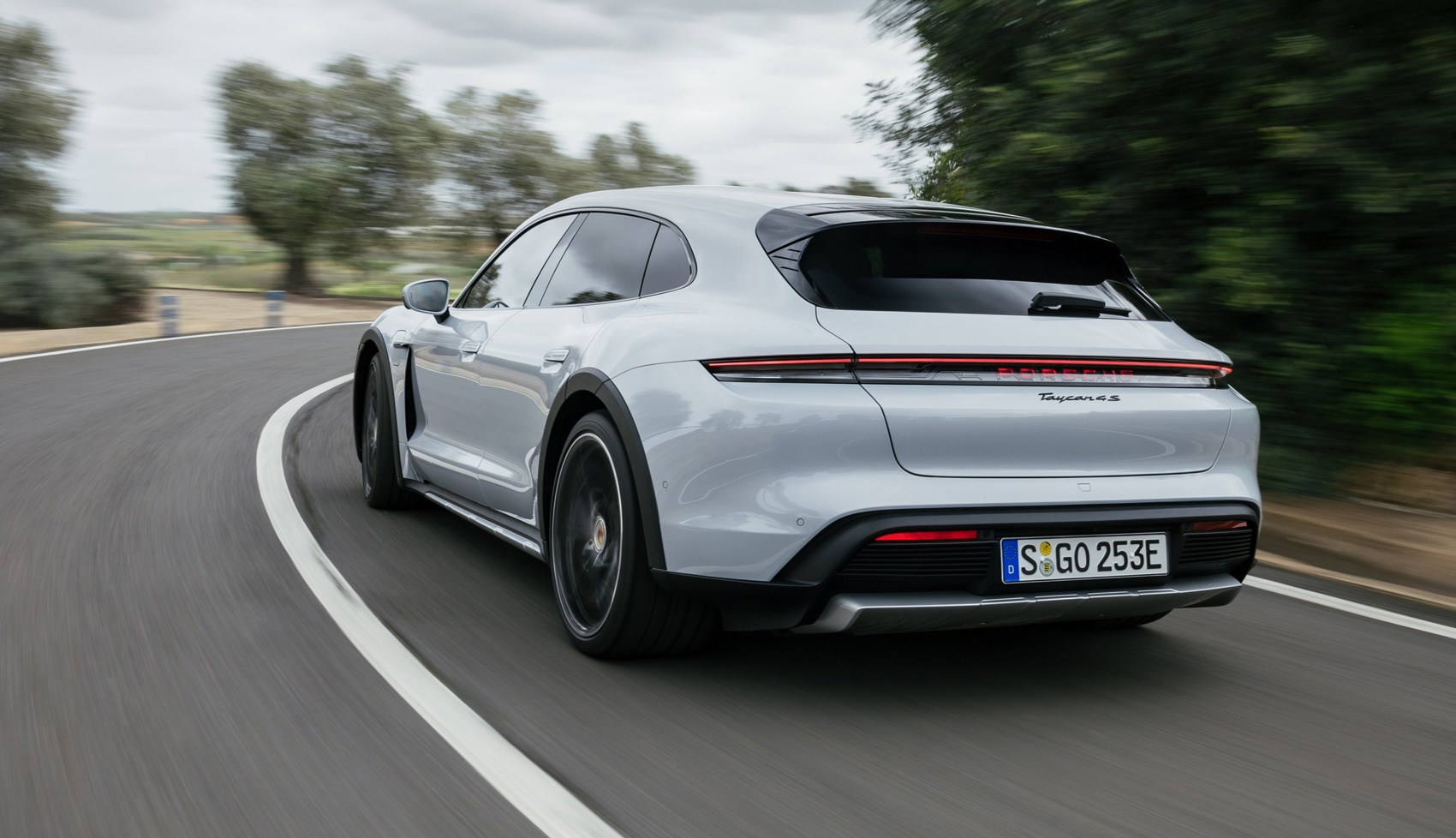► Facelifted Taycan Cross Turismo driven
► More power, more range, more features
► Porsche Active Ride carefully considered
A mid-life facelift for the Porsche Taycan is not something to be taken lightly. No pun intended. A machine we’ve elsewhere rated the best electric car on sale, it still seems visually alluring and technically impressive four years and nearly 150,000 sales after launch. Yet the EV market moves ever quicker, and to keep up Porsche has boosted the Taycan’s performance and driving range in order to maintain its authority.
Top of the tree now sits the properly ludicrous (…) Taycan Turbo GT with its 1093bhp capability, but driving impressions of that version are embargoed for a little while longer. So we spent our time on the launch event driving a Taycan Cross Turismo 4S – heart of the range in terms of power and performance, wrapped up in maximum lifestyle.
Pros: Better battery, more performance, clever Active Ride, still great to drive
Cons: Active Ride occasionally odd, braking still a touch inconsistent
What’s new?
Visually, there’s not a lot to spot – the headlights are narrower, and the rear Porsche script can be illuminated. There are some new, more aerodynamic wheel designs. Those headlights are also available with HD-Matrix technology for the first time: 32,000 individual pixels of light that can cast up to 600m ahead as well as paint a ‘light carpet’ on the road to help you gauge the width of the car when moving through road works.

On the inside there are some reworked buttons and new two-tone leather finishes available (non-leather options are also available for the sustainably minded). More eyes are likely to be drawn to the optional Passenger Display screen – except those of the driver, because a filter means you genuinely can’t see it from behind the wheel. So far this is similar to upgrades already delivered in the Porsche Cayenne.
The technical enhancements are more noteworthy. Changes to the rear electric motor (lighter, more powerful) and the battery composition mean some variants go 35 per cent further now, according to the official WLTP measurements. The 800v charging system has been ramped up to a 320kW max, with the revised battery chemistry, improved thermal management and other tricks also making a significant difference. All versions are now faster off the line and have higher overboost, up to 94bhp.
There are changes to the driving experience, too, with every Taycan now equipped with two-chamber air-suspension as standard (previously the most basic cars came on steel springs; the Cross Turismo has always been on air). More fun still is the new Porsche Active Ride option, which replaces Porsche Dynamic Chassis Control.

This adds a hydraulic pumping unit to each damper that can control the suspension response at each corner of the car with exceptional speed and precision. This not only promises an outstandingly smooth ride, it can also dynamically intervene against pitch and roll – ditching the traditional anti-roll bars in the process.
So instead of gamely staying flat in the turns, the Taycan can actively lean into them instead – the system able to prevent squatting and diving during hard acceleration and braking as well. It’s very clever, and very effective. But that’s not necessarily always a win, as we’ll explain.
What are the specs?
The Cross Turismo range is slightly more limited than the regular Taycan range; every model is all-wheel drive, so instead of starting with the standard rear-wheel drive Taycan as the saloon and Sport Turismo estate do, the entry-level Cross is badged 4, then you get the 4S (as tested here), Turbo and Turbo S – with the range-topping Turbo GT variants also limited to the saloon.
None of them are slow. The 429bhp Taycan 4 Cross Turismo does 0-62mph in 4.7sec, while the 590bhp Taycan 4S Cross Turismo slashes that to 3.8sec. The Turbo models are simply bonkers: with 0-62mph in 2.8sec for the 872bhp Taycan Turbo Cross Turismo and just 2.5sec for the 939bhp Taycan Turbo S Cross Turismo.
Frankly, the 4S feels fast enough. Launch control (stand on brake with left foot, plant right foot on the floor, release left) and a push-to-pass button on the steering wheel makes each of these cars’ performance effortlessly accessible.
Range and charging
To go as far as possible between plugs you’ll need a rear-wheel drive Taycan and the Performance Plus Battery (97kWh of usable capacity instead of 82.3kWh, optional on most Taycan saloons and Sport Turismos). This claims 422 miles per charge.
The Cross Turismo gets the Performance Plus Battery as standard, but with an extra motor and the off-road styling schtick (which doesn’t make that much difference given the variable ride-height capability of the air suspension) both the 4 and 4S max out at a claimed 381 miles per charge. The Turbo and Turbo S claim 373 and 372 miles, respectively.
Maximum charging speed has stepped up to 320kWh, as mentioned above. But what’s really handy is that Porsche has not only increased the amount of time that maximum charging speed is available (still only five minutes, but even that makes a difference), it’s also achieved faster charging over a much wider range of battery temperatures.
Previously, the optimum charging temperature for Taycan battery packs was 35 degrees – now it’ll start necking the juice at haste from just 15 degrees. At full whack you should get 186 miles of extra range in 10 minutes; but this since that stat will vary with driving style, a better measure is probably 10-80 per cent charge in just 18 minutes. Potentially less than half the time of the pre-facelift Taycan, even though the new battery is bigger.
An updated display in the digital instrument cluster shows you battery temp and predicted maximum charging speed at the current battery status, allowing you to be even more strategic about your pitstops. Useful stuff.
How does it drive?

More than any other Taycan, the Cross Turismo looks like some kind of sleek running shoe – and boy does it live up to such athletic associations. This might be a relatively humble 4S variant but it is fast, fast, fast. That 590bhp headline is an overboost figure, but even without it you get 510bhp; if you can’t manage the overtake you’re thinking of it was just plain dangerous in the first place. EVs have changed the performance game forever, and this is a primary example of that.
Outright speed is only one part of the Porsche equation, though. The Taycan has always had the steering and chassis sweetness that diehard driving enthusiasts crave, setting it apart from the pure numbers game. And now we have the added complexity of Porsche Active Ride to consider, as well as some on-going (minor) grumbles about the braking.
Active Ride first. This is impressively implemented but we still have some reservations, as it is, by its very nature, interfering with the way your built-in gyro – and that of your passengers – expects a car like this to respond. This may promote some feelings of nausea in some situations, especially in combination with the general lack of inertia present in high-performance electric drivetrains.
Your body can get weirded out, basically. For though the system is super speedy – and far superior to previous attempts at the same shenanigans – you can still feel it making corrections. Porsche, being Porsche, has anticipated this, and the more controversial Active Cornering Dynamics and Acceleration and Braking Comfort feature only operate in the Normal drive mode setting – the one in which you’re least likely to be seriously pressing on.
But hang on a moment. Not only does Active Ride deliver actually incredible ride comfort, if you keep it smooth you can cover ground at a fantastic rate in such a manner you might not even raise the other occupants’ eyebrows. We still preferred the tauter, more authentic reactions of Sport and (especially) Sport Plus when really getting a wriggle on, mind.
As with rear-wheel steering, Porsche has fundamentally pulled a blinder here. And once you’re used to it, we doubt you’ll ever want to go back to boring old active anti-rollbars. It’s similar to the transition to EV performance in that way.

That said, we’re still not totally keen on the Taycan’s braking, which is an aspect of this same EV revolution. While you can pick between a couple of regen settings, Porsche mostly prefers to do recuperation – now up to 400kW – via the left pedal. This not only means there’s very little one-pedal effect when you lift off the accelerator (something you may need to adapt into your driving style) you also get to experience the software juggling the moment regen cedes to friction.
This adds a creeping sensation of inconsistency that you don’t get with the best conventional performance cars. Will be interesting to find out how the forthcoming hybrid 911 deals with this issue.
As a Cross Turismo, this Taycan has a 20mm higher default ride height that can be increased by a further 10mm in the model-specific Gravel setting. So, a standard Taycan will potentially have a small centre of gravity edge. Good luck detecting this on the road without attracting the constabulary – with the Active Ride and air-suspension, excessive body roll is definitely not an issue, whereas the occasional bit of additional ground clearance might sometimes be handy.
What about the interior?
Nicely modern, very well put together, possessed of the same infuriating touch-sensitive climate control panel approach as other Porsches. And by touch sensitive we mean you have to stab at it to get a response as the entire panel is a giant button. This looks flash until you get fingerprints all over it and are struggling to find the right section to hit at 120 on the autobahn at night.
Cross Turismo (and Sport Turismo) get more rear headroom and a bigger boot. There’s plenty of space for four adults, but we wouldn’t want to be the fifth on a long journey.

Aside from the Passenger Display and some annoying EU-mandated safety systems – the automatically on speed limit exceeded warning is a particular favourite; we know what the customisable button on the steering wheel would be doing for us – the other major interior tech upgrade is extended Apple CarPlay integration.
This means you can control some of the car’s functions without exiting the CarPlay interface. If you’re an Android Auto user, no such luck – but you’ll probably still appreciate the air-conditioned wireless charger intended to prevent your phone overheating.
Before you buy (trims and rivals)
Porsche doesn’t do trim levels as such, instead the standard kit you get is linked to the powertrain. In the Cross Turismo, for instance, you get four-wheel drive on all models and the Performance Plus Battery.
The options list is extensive – and dangerously expensive. Want Active Ride? That’ll be another £6291. Torque Vectoring? £1158. Rear-wheel steering? £1593. The Off-Road Design Package? That’s upwards of £1278. And so on. May your wallet be deep and your instincts wise, since we’d certainly struggle to stop getting carried away.
There aren’t many direct rivals for the Cross Turismo. The BMW iX, perhaps, or the inevitable Tesla, though the most obvious S and X are left-hand drive only now. The Audi e-Tron GT uses the same platform as the Taycan but even that isn’t quite at this level of holistic allure. We have, however, heard a few stories of Taycan reliability woes, so here’s hoping dependability has had some attention as part of the facelift as well.
Porsche Taycan Cross Turismo – the initial verdict
If you want a premium quality high-performance electric car that almost do it all – and don’t want an electric SUV – then we can’t think of a better choice than the Taycan Cross Turismo. In fact, the decision wouldn’t even be close. The Porsche isn’t perfect, but nothing else does so much so well, nor makes £100k+ seem like such good value for money.
Specs below are for the 2024 Porsche Taycan 4S Cross Turismo